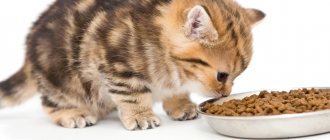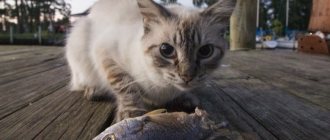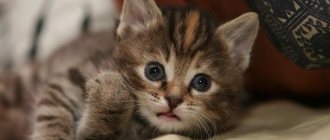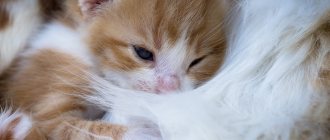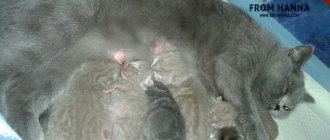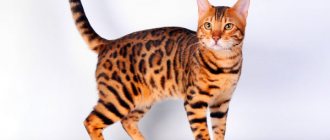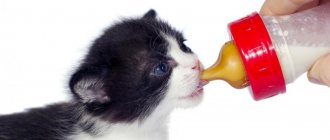Veterinarians believe that baby food for cats is healthy if it does not contain flavor enhancers, starch, vegetables or spices that are exotic for the animal. Meat and vegetable gruels, as well as infant formula, are suitable for feeding babies. It should be taken into account that the product for children contains an increased concentration of fats, oils, minerals and vitamins, which can cause obesity or hypervitaminosis in the animal. Therefore, you need to accurately measure the volumes and give your baby food according to a strict schedule.
Tema meat and vegetable puree “Beef with buckwheat” - review
Until recently, I didn’t know that cats simply adore “Tyoma” meat-and-vegetable puree... In fact, they are intended for feeding children from 8 months. But my cats (two) eat exclusively natural food (chicken, beef, turkey) and there is a lot of fuss with preparing their food separately... but there are fewer health problems than those who eat industrial food. So, after an illness, I had a weakened cat (one year old). She is not good at eating meat, because she quickly gets tired of chewing it, and I don’t always have time to process meat into minced meat... While I was treating her, I studied information about nutrition on cat breeder forums and discovered that those who feed animals natural food use nutrition, baby food such as “Tyoma”, “Babushkino Lukoshko”, “Gerber” and others (it is only important that there are no potatoes, no pork and no fish. Important. Make sure that the composition does not contain onions, garlic, soy protein). I decided to try it... I bought “Tyoma” puree with beef and buckwheat. It turned out to be an excellent food for a cat... It’s so mouth-watering that you can’t tear it off. Since it is puree and not a piece of meat, there is no need to chew it, and she does not get tired. Easily digested. Dietary (relatively of course). Goes to the toilet perfectly - without diarrhea, but also without constipation. I just started to recover at a rapid pace (pah-pah). The appetite is wolfish - he eats 2 jars a day, quickly regains the weight lost during illness. She eats it so much that she doesn’t have to persuade her (it’s apparently still hard for her to digest meat after her illness). One jar contains 100 grams of the finished product. And what I like most is that usually I can’t force cats to eat, in addition to meat, vegetables and porridge (cereals - buckwheat, rice, etc.), but in the form of puree they crack “with a bang.” This is important because they also need carbohydrates, not just proteins... especially if the animal has weak or diseased kidneys, then they need less protein. The main thing is that it contains no lactose, preservatives, GMOs, flavors and dyes... and other rubbish. The composition is as follows: beef; buckwheat; sunflower oil, potato starch, table salt (but I tried the taste - the canned food is completely bland, there is very little salt in my opinion... just what is needed for cats); dill extract, water. I think it's a good lineup! However, there is one small inconvenience: after opening the can, the product’s shelf life = 1 day. After this it cannot be used. Mine are great at persuading a whole jar in a day and more than one. So there is no problem with this. The manufacturer also recommends warming it up slightly... There is a catch here: if you heat up a portion and it doesn’t eat it all at once, then reheating it is prohibited - all you have to do is throw it away if you don’t eat it. I can tell you from my own experience - I DO NOT reheat it, it already smells like meat. I leave the jar to sit at room temperature (although these canned foods do not require a refrigerator) and serve it that way. They eat great. After heating in the microwave, these canned foods simply become more flavorful. This does not affect my cats in any way, since they eat it just fine without heating. I highly recommend it to those who have cats on natural food and to those who are recovering from an illness. PS: we also tried the “Babushkino Lukoshko” puree with beef and pumpkin... I (and the cats) personally liked it better, why - I’ll write a separate review. Appearance, consistency, composition are demonstrated in the photo.
When can you feed your cat baby food?
Is it possible to feed a cat baby food? This is a natural question that arises for any caring owner. Such a diet is acceptable if the animal is recovering from a serious illness or suffers from weak teeth. in this case, the liquid form of baby food will help maintain the health of the animal, stimulating it to recover.
This diet is optimal for small cats and older cats. Kittens under six months usually cannot boast of healthy and strong teeth, so veterinarians recommend feeding them liquid food. Baby food will also be a useful and reliable source of vitamins. This diet is also suitable for an elderly cat, because her teeth are usually extremely sensitive and fragile.
It is worth giving such puree to an animal only if the cat is not allergic to its components. It is worth carefully studying the packaging, making sure that there is no place for onions, garlic and salt in the baby food. It is also worth making your animal’s diet varied, using not only vegetable puree, but also meat puree.
Usually, meat baby food is no longer produced in the form of puree, but in the form of tiny pieces that both the child and the animal can easily digest.
It is also worth feeding your pet baby food if the animal is recovering from a major operation. Now the cat needs the most balanced diet that will not impair the functioning of the digestive system. In this case, baby food becomes a reliable source of vitamins, and if these canned foods also turn out to be hypoallergenic, then the pet will definitely begin to feel good.
Many pet owners believe that they can safely feed their cat expired baby food without worrying about the consequences. In fact, such a diet, based on expired products, can result in poisoning and complications in the digestive system.
Do I need to add any of the following to dry food?
No, if you give your kitten a complete, balanced food, it already contains all the ingredients listed: animal proteins, fats, beneficial micro- and macroelements, probiotics, fiber.
Pay attention only to the composition of the product: all components must be clearly indicated (not just “meat”, but for example, “fresh turkey meat”). If it is impossible to calculate the percentages even approximately, it is better to choose a different diet for the kitten, with a more transparent composition. We believe that this information is very important for owners, so we indicate the percentages of each ingredient!
We do not recommend mixing ready-made food with natural food, even at different feedings: you will not be able to determine how many nutrients the kitten receives, and it is very easy to make a mistake with the dosages. In addition, such mixing is a direct path to food vagaries in the future.
When should you not feed your cat baby food?
The first thing you should pay attention to is the animal’s reaction to a change in diet. If your pet resists eating baby food with all his might, he should not be forced. You should also not take risks if your pet has a hypersensitive digestive system. In such cases, the risk of an allergic reaction to food components is too great.
It was already mentioned above that under no circumstances should you give your cat baby food containing onions and garlic. The thing is that these two vegetables contain a disulfide component, which affects the destruction of red blood cells in the cat’s body. The constant presence of disulfide in the blood leads to the formation of hemolytic anemia and can be fatal. If baby food contains sugar or salt in large quantities, it should also not be given to your pet. Otherwise, this will result in serious disruptions in the functioning of the digestive system.
Another common mistake is using exclusively meat baby food for your cat’s diet. In the wild, cats also eat a variety of grass and vegetables. Without the presence of plant foods in the diet, the pet’s body will not function normally. That is why you can safely add pieces of carrots or tomatoes to the meat puree.
Typically, caring owners use baby food in cases where it is necessary to transfer the animal from old food to new food. In such cases, special mixtures designed for babies will help add the necessary variety to the diet, accustoming the pet to a new feeding algorithm.
Veterinarians advise using baby food of the Agusha and Tema brands. It is believed that such food contains exclusively natural ingredients, and there is no room for salt, sugar and various preservatives in their composition.
Proper nutrition for a pet is a real science that requires patience from the cat owner. You can use baby food as the basis for your diet, but you should also take into account the individual needs of your pet.
The unexpected discovery of a newborn kitten on the street or a mother cat abandoning her offspring is a reason for panic not only for beginners, but also for experienced animal owners. How to take care of the baby, how to protect it? There are a lot of opinions and advice on this matter, but the main stumbling block is proper feeding. Let's figure out whether it is possible to feed a kitten with baby food and what can be done to keep the baby healthy.
When is it recommended?
Formulas for children can be given to the following representatives of the cat family, which will benefit from a soft puree-like structure and a high concentration of minerals:
This food is suitable for older animals.
- babies from 0 to 6 months left without a mother;
- a pet weakened by illness;
- old cats with poor condition of fangs;
- pets switching from one food to another;
- cats during pregnancy and lactation.
About feeding kittens
Let us immediately determine that a blind kitten on the street, even if it is in a box and covered with a cloth, is a non-resident. If you find such a find, the decision is yours! Feeding kittens is a big responsibility and literally sleepless nights.
The only chance to save a newborn kitten that is not fed by a cat is a person. Even if you decide that you cannot help your baby, there are some things you can do:
- Try to find someone who can pay attention to feeding, taking the kitten for a while. Going to a clinic where the kitten will be euthanized - you may think that this is cruel, but is a slow, starving death more humane?
The next important point is the chances of survival. If you take on feeding babies that have been rejected by a cat, that is, they were warm, were not injured, etc., the chances of survival are higher. If you find a blind kitten on the street, you should be prepared for the fact that it may die due to:
- Hypothermia. Too much hunger. Received injuries.
Note! Cats are very good mothers and they rarely abandon their offspring, but if this happens, the babies need to be shown to a doctor.
The fact is that a cat can leave offspring if they are not viable, for example, premature. In this case, if you decide to feed orphan kittens, all the risks and scenarios will be known to you in advance.
The chances are very low for kittens that have not developed a sucking reflex or the digestive process has stopped. A stop can happen for two reasons:
- The kitten has been starving for too long. The kitten has never suckled milk; in fact, in this case, digestion has not yet started and the chances of survival are higher.
The absence of an oral reflex is almost always tantamount to doom. A kitten may refuse to suckle if the reflex is not yet developed (prematurity) or if it is too weak (precomatose or lethargic).
Tip: In the early stages of lethargy, a kitten can be brought back to consciousness by warming it up and vigorously (but gently) rubbing the body from the limbs to the heart.
So, you have a newborn kitten, what should you do first? Decide what and how to feed. We will talk about choosing the type of feeding below; there are several answers to the question of what to feed:
- A syringe without a needle is not the most convenient method, but it will work as a temporary solution. A pipette is also not the most convenient method, since the kitten knows how to suck, not lick. A syringe with a rubber nozzle - a rubber band from a pipette, a piece of tube from a dropper or a rubber catheter is put on the hard nose of the syringe. The kitten will be able to suck on the rubber nozzle, and with the help of the piston it will be convenient for you to control the flow of milk. Just one caveat - make sure that the kitten does not suck in the nozzle; it must hold securely. Container for drops for the nose, ears, etc. - the tube must be thoroughly rinsed, doused with boiling water and make sure that there are no foreign odors left in it. A special bottle for feeding kittens - like a baby bottle, with a nipple, only much smaller.
Important! The kitten must suck, that is, make an effort to get milk. If you simply pour the mixture into your baby's mouth, he may lose his sucking reflex.
Rules and frequency of feeding kittens
Do not be alarmed if the baby sucks weakly during the first feedings; he may be exhausted. If everything goes well, you will see the baby’s assertiveness; you won’t even have to press on the plunger of the syringe or bottle, the kitten will suck everything out on its own, and very quickly. However, here we are talking about a one-month-old kitten; in the first day and even weeks, you should not expect such progress.
Let's talk about the general rules that must be followed, despite the age and condition of the ward:
- Kittens are fed only in a prone position (natural) or held upright (with a weakened sucking reflex). If you place your baby on his back, there is a risk of suffocation. Strictly control the gradual flow of the mixture, since the kitten may inhale excess liquid. The bottle should be held at a comfortable angle for the kitten, but not vertically or horizontally. Never force-feed the remaining formula, even if it seems to you that the baby has not eaten enough. It is better to take a break and offer the pacifier again after 30–40 minutes. After feeding, massage the kitten's stomach and genital area with a damp sponge - if you skip this step, the baby will not be able to go to the toilet, will suffer from intoxication and will most likely die.
Important! A bottle-fed kitten has a weak immune system! Monitor the cleanliness of the bedding, nipples and bottles, the freshness of the mixture, the temperature conditions and the absence of drafts.
Now let's look at the frequency of feeding. Let’s decide in advance that the kitten eats until it’s full and falls asleep. For a one-day-old baby, eating takes about 5 minutes; the older the kitten gets, the faster he will cope with the pacifier. We weren’t kidding about sleepless nights above; a newborn kitten eats every 2–3 hours, a week-old kitten eats every 4 hours... both day and night.
You will understand whether your baby has enough food and nutrients if you weigh your ward. Until about 3 weeks of age, the baby should gain 10–15 grams every day.
Age Recommendations and feeding frequency
| 1 week (1–7 days) | Feed every 2-3 hours. From the fifth day, if the kitten does not wake up on its own, the frequency of night feeding is increased to 1 time every 3 hours. |
| Week 2 (7–14 days) | Feeding every 4 hours. From the tenth day, if the kitten does not wake up on its own, the frequency of night feeding is increased to 1 time every 5 hours. |
| Week 3 (14–21 days) | Feeding every 5-6 hours. Physically strong kittens from 15–20 days should be taught to lap from a saucer. |
| Week 4 (21–28 days) | Feeding every 5-6 hours. From 23–25 days you should try to introduce complementary foods and strictly monitor the reaction of the digestive system. If necessary, you need to use drugs to eliminate colic. |
Note! By the fifth week, the kitten should be able to lap from a saucer. From the fifth week you need to expand the diet - give boiled minced meat, broths, fermented milk products.
What to feed a kitten?
It's time to figure out what to feed the kitten. Naturally, the best option is to find a nursing cat who will accept the orphan. Before the invention of cat milk replacers, newborn kittens (and puppies) were fed cow's or goat's milk.
- Goat's milk was considered a better option because it contains more lactobacilli. Cow's milk has never been recognized as a good means of feeding, but there were no particular alternatives. Today, cow's milk is categorically not recommended for feeding kittens, and goat's milk is encouraged to be diluted with water in a 1:1 ratio.
Note! If you feed your kitten cow's or goat's milk, monitor the condition of its skin and stool. The fact is that the baby may be allergic to lactose in foreign milk, and it is very difficult to notice.
Infant formulas are successfully used to feed newborn kittens, but:
- Make sure there is no sugar in the mixture. Choose a formula “from scratch”, that is, for newborns, and not two- or three-month-old children. If you were unable to buy a “from scratch” mixture, make sure that the selected product does not contain additives (berries, honey, cereals). Dilute any baby formula with twice as much water as indicated in the instructions. Store the mixture only in the refrigerator. Do not feed formula that was prepared more than 24 hours ago.
The best choice would be a special mixture - a cat's milk replacer. This powder must be diluted according to the instructions and dosed according to the recommendations given on the package. Using a cat milk substitute significantly reduces the risk of allergies, although it does not eliminate it.
Note! Grown-up kittens can be fed with meat baby food, without the addition of fruits, sugar, potatoes, broccoli and other unnatural for a cat's diet.
Restrictions on use
Veterinarians do not recommend getting carried away with canned food and formula; if the animal has problems with the gastrointestinal tract, it is better to buy special artificial milk for feeding kittens. Allergy sufferers need to carefully examine the composition. If the kitten spits out the mixture or turns away its face, then you need to choose a different food. It is impossible to feed an animal exclusively with meat mixtures, because fiber must be present in the diet.
An artificial product containing preservatives and flavor enhancers is contraindicated for animals. If you are lactose intolerant, milk slurry is also prohibited. To identify this physiological feature, you need to monitor your pet's stool after eating food. When the pet reaches the age of 35 days, it is necessary to introduce complementary foods made from natural products - cottage cheese, meat, bran and stewed vegetables, and leave the mixture as an addition to the main menu.

